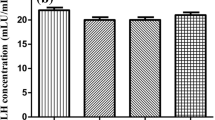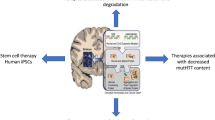Abstract
This study aimed to investigate the role of lncRNA FENDRR in apoptosis of Leydig cells and the further mechanism. The apoptosis of Leydig cells (TM3 cell line) was induced by H2O2-treatment and detected by flow cytometry. The function of FENDRR was determined by in vitro and in vivo silencing experiments. The mechanism of FENDRR in regulating the expression of nuclear factor erythroid 2-related factor 2 (Nrf2) was assessed by RNA immunoprecipitation, RNA pull-down, and ubiquitination assays. FENDRR expression was up-regulated in H2O2-treated TM3 cells. Knockdown of FENDRR augmented Nrf2 and HO-1 protein levels and testosterone production in H2O2-treated TM3 cells, whereas the apoptosis rate and caspase 3 activity were decreased. Mechanically, FENDRR bound to Nrf2 and promoted its ubiquitination and degradation. Nrf2 overexpression reversed the effects FENDRR overexpression on apoptosis, caspase 3 activity, and testosterone concentration in H2O2-treated TM3 cells. The in vivo experiments showed that FENDRR silence increased serum testosterone level and improved testosterone-related anti-depression behaviors of late-onset hypogonadism (LOH) mice. Our findings suggested that FENDRR could promote apoptosis of Leydig cells in LOH partly through facilitating Nrf2 degradation.






Similar content being viewed by others
References
Bae WJ, Ha US, Choi JB, Kim KS, Kim SJ, Cho HJ, Hong SH, Lee JY, Wang Z, Hwang SY et al (2016) Protective effect of decursin extracted from Angelica gigas in male infertility via Nrf2/HO-1 Signaling pathway. Oxid Med Cell Longev 2016:5901098
Bae WJ, Zhu GQ, Choi SW, Jeong HC, Bashraheel F, Kim KS, Kim SJ, Cho HJ, Ha US, Hong SH et al (2017) Antioxidant and antifibrotic effect of a herbal formulation in vitro and in the experimental andropause via Nrf2/HO-1 signaling pathway. Oxid Med Cell Longev 2017:6024839
Corona G, Rastrelli G, Maseroli E, Forti G, Maggi M (2013) Sexual function of the ageing male. Best Pract Res Clin Endocrinol Metab 27(4):581–601
Diemer T, Allen JA, Hales KH, Hales DB (2003) Reactive oxygen disrupts mitochondria in MA-10 tumor Leydig cells and inhibits steroidogenic acute regulatory (StAR) protein and steroidogenesis. Endocrinology 144(7):2882–2891
Dong B, Zhou B, Sun Z, Huang S, Han L, Nie H, Chen G, Liu S, Zhang Y, Bao N et al (2018) LncRNA-FENDRR mediates VEGFA to promote the apoptosis of brain microvascular endothelial cells via regulating miR-126 in mice with hypertensive intracerebral hemorrhage. Microcirculation 25(8):e12499
Evans JR, Feng FY, Chinnaiyan AM (2016) The bright side of dark matter: lncRNAs in cancer. J Clin Investig 126(8):2775–2782
Gao X, Zhu M, An S, Liang Y, Yang H, Pang J, Liu Z, Zhang G, Wang F (2020) Long non-coding RNA LOC105611671 modulates fibroblast growth factor 9 (FGF9) expression by targeting oar-miR-26a to promote testosterone biosynthesis in Hu sheep. Reprod Fertil Dev 32(4):373–382
Gautam DK, Misro MM, Chaki SP, Sehgal N (2006) H2O2 at physiological concentrations modulates Leydig cell function inducing oxidative stress and apoptosis. Apoptosis Int J Program Cell Death 11(1):39–46
Gong F, Dong D, Zhang T, Xu W (2019) Long non-coding RNA FENDRR attenuates the stemness of non-small cell lung cancer cells via decreasing multidrug resistance gene 1 (MDR1) expression through competitively binding with RNA binding protein HuR. Eur J Pharmacol 853:345–352
Gong L, Zhu L, Yang T (2020) Fendrr involves in the pathogenesis of cardiac fibrosis via regulating miR-106b/SMAD3 axis. Biochem Biophys Res Commun 524(1):169–177
Gutschner T, Hammerle M, Eissmann M, Hsu J, Kim Y, Hung G, Revenko A, Arun G, Stentrup M, Gross M et al (2013) The noncoding RNA MALAT1 is a critical regulator of the metastasis phenotype of lung cancer cells. Cancer Res 73(3):1180–1189
Hadziselimovic F, Gegenschatz-Schmid K, Verkauskas G, Demougin P, Bilius V, Dasevicius D, Stadler MB (2017) GnRHa treatment of cryptorchid boys affects genes involved in hormonal control of the HPG axis and fertility. Sex Dev Genet Mol Biol Evol Endocrinol Embryol Pathol Sex Determ Differ 11(3):126–136
Haider SG (2004) Cell biology of Leydig cells in the testis. Int Rev Cytol 233:181–241
He Z, Wang X, Huang C, Gao Y, Yang C, Zeng P, Chen Z (2018) The FENDRR/miR-214-3P/TET2 axis affects cell malignant activity via RASSF1A methylation in gastric cancer. Am J Transl Res 10(10):3211–3223
Kim KH, Sadikot RT, Yeon Lee J, Jeong HS, Oh YK, Blackwell TS, Joo M (2017) Suppressed ubiquitination of Nrf2 by p47(phox) contributes to Nrf2 activation. Free Radic Biol Med 113:48–58
Lee SE, Jeong SI, Kim GD, Yang H, Park CS, Jin YH, Park YS (2011) Upregulation of heme oxygenase-1 as an adaptive mechanism for protection against crotonaldehyde in human umbilical vein endothelial cells. Toxicol Lett 201(3):240–248
Li Y, Zhang W, Liu P, Xu Y, Tang L, Chen W, Guan X (2018) Long non-coding RNA FENDRR inhibits cell proliferation and is associated with good prognosis in breast cancer. Onco Targets Ther 11:1403–1412
Li D, Dai C, Yang X, Wang F, Yu X, Xiao X, Tang S (2017) Critical role of p21 on olaquindox-induced mitochondrial apoptosis and S-phase arrest involves activation of PI3K/AKT and inhibition of Nrf2/HO-1pathway. Food Chem Toxicol Int J Publ Br Ind Biol Res Assoc 108(Pt A):148–160
Qiannan E, Wang C, Gu X, Gan X, Zhang X, Wang S, Ma J, Zhang L, Zhang R, Su L (2020) Competitive endogenous RNA (ceRNA) regulation network of lncRNA-miRNA-mRNA during the process of the nickel-induced steroidogenesis disturbance in rat Leydig cells. Toxicol In Vitro Int J Publ Assoc BIBRA 63:104721
Qin X, Lu M, Zhou Y, Li G, Liu Z (2019) LncRNA FENDRR represses proliferation, migration and invasion through suppression of survivin in cholangiocarcinoma cells. Cell Cycle 18(8):889–897
Shi Y, Chen C, Xu Y, Liu Y, Zhang H, Liu Y (2019) LncRNA FENDRR promotes high-glucose-induced proliferation and angiogenesis of human retinal endothelial cells. Biosci Biotechnol Biochem 83(5):869–875
Srinath R, Hill Golden S, Carson KA, Dobs A (2015) Endogenous testosterone and its relationship to preclinical and clinical measures of cardiovascular disease in the atherosclerosis risk in communities study. J Clin Endocrinol Metab 100(4):1602–1608
Tajar A, Forti G, O’Neill TW, Lee DM, Silman AJ, Finn JD, Bartfai G, Boonen S, Casanueva FF, Giwercman A et al (2010) Characteristics of secondary, primary, and compensated hypogonadism in aging men: evidence from the European Male Ageing Study. J Clin Endocrinol Metab 95(4):1810–1818
Tomczyk M, Kraszewska I, Dulak J, Jazwa-Kusior A (2019) Modulation of the monocyte/macrophage system in heart failure by targeting heme oxygenase-1. Vasc Pharmacol 112:79–90
Wang S, Ren X, Hu X, Zhou L, Zhang C, Zhang M (2019) Cadmium-induced apoptosis through reactive oxygen species-mediated mitochondrial oxidative stress and the JNK signaling pathway in TM3 cells, a model of mouse Leydig cells. Toxicol Appl Pharmacol 368:37–48
Whittaker DS, Wang HB, Loh DH, Cachope R, Colwell CS (2017) Possible use of a H3R antagonist for the management of nonmotor symptoms in the Q175 mouse model of Huntington's disease. Pharmacol Res Perspect 5(5)
Wu FC, Tajar A, Beynon JM, Pye SR, Silman AJ, Finn JD, O’Neill TW, Bartfai G, Casanueva FF, Forti G et al (2010) Identification of late-onset hypogonadism in middle-aged and elderly men. N Engl J Med 363(2):123–135
Yi Y, Zhao Y, Li C, Zhang L, Huang H, Li Y, Liu L, Hou P, Cui T, Tan P (2017) RAID v2.0: an updated resource of RNA-associated interactions across organisms. Nucleic Acids Res 45(D1):D115–D118
Yin SL, Xiao F, Liu YF, Chen H, Guo GC (2019) Long non-coding RNA FENDRR restrains the aggressiveness of CRC via regulating miR-18a-5p/ING4 axis. J Cell Biochem
Zang ZJ, Tang HF, Tuo Y, Xing WJ, Ji SY, Gao Y, Deng CH (2016) Effects of velvet antler polypeptide on sexual behavior and testosterone synthesis in aging male mice. Asian J Androl 18(4):613–619
Zhang G, Wang Q, Zhang X, Ding Z, Liu R (2019) LncRNA FENDRR suppresses the progression of NSCLC via regulating miR-761/TIMP2 axis. Biomed Pharmacother 118:109309
Zhao D, Ge H, Ma B, Xue D, Zhang W, Li Z, Sun H (2018) The interaction between ANXA2 and lncRNA Fendrr promotes cell apoptosis in caerulein-induced acute pancreatitis. J Cell Biochem
Funding
This study was supported by the National Natural Science Foundation of China (Grant No. 81700693).
Author information
Authors and Affiliations
Corresponding author
Ethics declarations
Conflict of interest
The authors declare no competing interests.
Additional information
Publisher's Note
Springer Nature remains neutral with regard to jurisdictional claims in published maps and institutional affiliations.
Supplementary information
Below is the link to the electronic supplementary material.
Rights and permissions
About this article
Cite this article
Liu, Y., Liu, Y., Wang, J. et al. LncRNA FENDRR promotes apoptosis of Leydig cells in late-onset hypogonadism by facilitating the degradation of Nrf2. Cell Tissue Res 386, 379–389 (2021). https://doi.org/10.1007/s00441-021-03497-6
Received:
Accepted:
Published:
Issue Date:
DOI: https://doi.org/10.1007/s00441-021-03497-6




